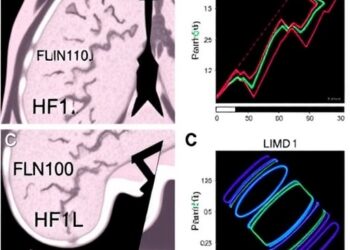Reactive oxygen species (ROS) from mitochondria are key drivers of genetic chaos in cancer by causing the collapse of micronuclear envelopes, a process that fuels the chromosomal instability (CIN) often observed in aggressive tumor behavior. These are the findings of two new studies. The findings identify key proteins in this destructive process – p62 and CHMP7 – revealing potential prognostic markers and therapeutic targets for high-CIN tumors. Errors in chromosome segregation during cell division can lead to chromosomal instability, a key feature of cancer. These errors result in the formation of micronuclei, which are small structures separate from the main nucleus that often contain lagging chromosomes or fragments. Unlike the main nucleus, micronuclei frequently rupture, releasing their DNA into the cytoplasm of the cell. This release causes DNA damage and genomic instability. It activates an immune response that can drive tumor-related inflammation and metastasis that can promote cancer progression. However, the mechanisms and molecular underpinnings governing micronuclear collapse are poorly understood.
Reactive oxygen species (ROS) from mitochondria are key drivers of genetic chaos in cancer by causing the collapse of micronuclear envelopes, a process that fuels the chromosomal instability (CIN) often observed in aggressive tumor behavior. These are the findings of two new studies. The findings identify key proteins in this destructive process – p62 and CHMP7 – revealing potential prognostic markers and therapeutic targets for high-CIN tumors. Errors in chromosome segregation during cell division can lead to chromosomal instability, a key feature of cancer. These errors result in the formation of micronuclei, which are small structures separate from the main nucleus that often contain lagging chromosomes or fragments. Unlike the main nucleus, micronuclei frequently rupture, releasing their DNA into the cytoplasm of the cell. This release causes DNA damage and genomic instability. It activates an immune response that can drive tumor-related inflammation and metastasis that can promote cancer progression. However, the mechanisms and molecular underpinnings governing micronuclear collapse are poorly understood.
Across two studies, researchers reveal the mechanisms that compromise micronuclear envelope integrity and disrupt the normal activity of the cellular machinery responsible for nuclear membrane repair (i.e., ESCRT-III complex). They show how both mechanisms are triggered by ROS and contribute to micronuclear collapse. Using proteomic analysis and genetic manipulations, Melody Di Bona and colleagues discovered that high levels of ROS disrupt the normal functioning of micronuclei by causing a build-up of a protein called CHMP7 inside the nuclear membrane. This accumulation, along with ROS-induced changes to changes to CHMP7, leads the protein to clump together and bind abnormally with the nuclear membrane protein, LEMD2, ultimately causing the micronuclear membrane to deform and break apart. In another study, Sara Martin and colleagues compared the proteins found in micronuclei to those found in the primary nuclei of cells to identify those involved in the rupture and repair of micronuclear envelopes. According to the findings, the p62 protein, which plays a crucial role in the cell’s autophagy process, is abundant in micronuclei and affects their stability. Similar to the companion study, Martin et al. found that ROS from nearby mitochondria causes p62 to aggregate, making the repair function of the ESCRT-III complex less effective. “Further research into the interplay between micronuclei and mitochondria could reveal additional insights into cellular stress responses and cancer pathogenesis,” write Marianna Maddaluno and Carmine Settembre in a related Perspective. “By exploring these mechanisms, the cellular processes that contribute to aggressive cancer behaviors can be better understood, potentially leading to new avenues for treatment and prevention.
Journal
Science
Article Title
Micronuclear collapse from oxidative damage
Article Publication Date
30-Aug-2024




